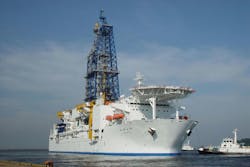Offshore staff
RESTON, Virginia – The US Geological Survey (USGS) has helped discover large, highly enriched accumulations of natural gas hydrate in the Bay of Bengal offshore eastern India, which could be producible.
Natural gas hydrates are a naturally occurring, ice-like combination of natural gas and water found in oceans and polar regions. The volume of gas within gas hydrate accumulations could greatly exceed all known conventional gas resources, USGS claims.
Scientists from India, Japan, and the United States conducted ocean drilling, conventional sediment coring, pressure coring, downhole logging, and analytical work to assess the geologic occurrence, regional context, and characteristics of gas hydrate deposits offshore India.
TheIndian National Gas Hydrate Program Expedition 02 was the second international partnership. The preceding expedition also discovered gas hydrate accumulations, but in formations unlikely to be producible.
Prior studies had shown that gas hydrate at high concentrations in sand reservoirs represented the best combination for production using existing technologies, and this was the target for Expedition 02.
The gas hydrate encountered was in coarse-grained sand-rich depositional systems in the Krishna-Godavari basin and comprises a sand-rich, gas-hydrate-bearing fan and channel-levee gas hydrate prospects.
The next steps will include production testing in these sand reservoirs to determine if natural gas production is practical and economic.
USGS senior scientist Tim Collett said: “The discovery of what we believe to be several of the largest and most concentrated gas hydrate accumulations yet found in the world will yield the geologic and engineering data needed to better understand the geologic controls on the occurrence of gas hydrate in nature and to assess the technologies needed to safely produce gas hydrates.”
The international team was led by ONGC on behalf of the Ministry of Petroleum and Natural Gas India, in cooperation with the USGS, the Japanese Drilling Co., and the Japan Agency for Marine-Earth Science and Technology.
In addition, USGS is working with the National Institute of Advanced Industrial Science and Technology Japan to analyze pressure core samples collected from sand reservoirs with high gas hydrate concentrations.
07/26/2016
Share your news withOffshore at [email protected]



